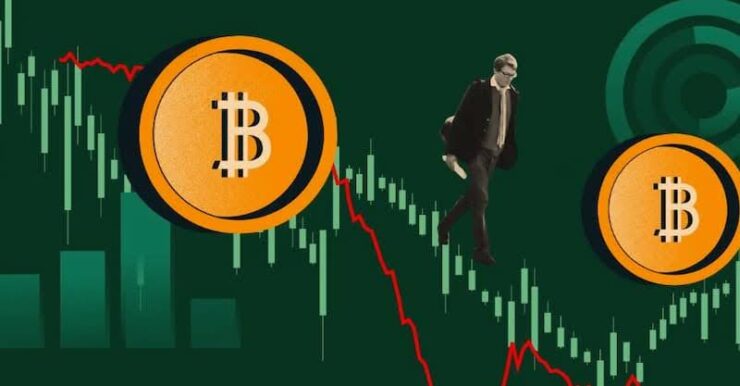The crypto market is unpredictable, with prices swinging wildly overnight. When fear takes over, many investors rush to sell, locking in losses instead of waiting for recovery.
But history also proves that these crypto dips are temporary, and those who stay calm often appear ahead. Before making any impulsive decision, consider the long-term potential.
Matthias, host of The CoinRock Show, strongly advised against making impulsive decisions driven by fear. He emphasized that those who hold through corrections often come out on top, while panic sellers typically miss out on the eventual recovery.

Market Cycles: Corrections Are Normal
Crypto markets have a well-documented history of violent corrections followed by massive rebounds, often shaking out weak hands before the next rally. These downturns may seem catastrophic in the moment, but they have repeatedly proven to be temporary phases in a broader growth trajectory.
In March 2020, Bitcoin dropped to $3,800 during the COVID-induced market crash, as panic gripped global financial markets. However, within just 18 months, it surged past $69,000, proving that those who held through uncertainty reaped the biggest rewards.
A similar pattern unfolded in 2018, when Bitcoin plunged from $20,000 to $3,000, only to rise above $60,000 in the next bull cycle. These corrections wiped out overleveraged traders and short-term speculators, but long-term holders who stayed the course saw exponential gains.
The current dip has once again sparked widespread fear, with many questioning if the bull run is over. However, looking at historical market cycles, pullbacks are not only common but also essential for healthy market growth.
These corrections often reset overinflated prices, clear out excessive leverage, and set the stage for sustainable long-term gains. Investors who panic sell during these phases often chase higher prices when the market recovers, while disciplined holders and strategic buyers position themselves for the next wave of profits.
Matthias on market corrections:
“If you’re panicking right now, take a step back. Every major rally in crypto was preceded by brutal corrections. The real mistake is selling at the bottom, only to watch prices rebound.”
As history has shown, volatility is not a sign of market failure—it’s a fundamental part of crypto’s DNA. Those who embrace the cycles, rather than fight them, stand to benefit the most when the market inevitably turns bullish again.

Institutional Investors Are Still Buying
Despite the market downturn, big money isn’t leaving crypto. While retail traders may be feeling the pressure of declining prices, institutional investors continue to accumulate, proving that confidence in the long-term potential of digital assets remains intact.
Historically, large institutions and high-net-worth investors tend to buy during periods of fear and uncertainty, capitalizing on market dips while the majority panic-sell.
MicroStrategy, the largest corporate holder of Bitcoin, now owns over 214,000 BTC, reinforcing its commitment to Bitcoin as a long-term store of value. The company has consistently added to its holdings even during past bear markets, demonstrating its unwavering belief in Bitcoin’s future.
Similarly, MetaPlanet has aggressively expanded its Bitcoin holdings, closely following Michael Saylor’s accumulation strategy and further solidifying Bitcoin’s status as an institutional-grade asset.
Beyond corporate entities, BlackRock and Fidelity—two of the world’s largest financial institutions—continue to push crypto investment products, signaling that institutional demand is still steadily increasing.
BlackRock’s Bitcoin ETF has attracted billions in inflows, proving that despite short-term market swings, the appetite for crypto exposure among traditional financial players remains strong.
The growing adoption of regulated investment vehicles indicates that crypto is no longer a fringe asset class but is gradually being integrated into mainstream finance.
If the bull market were truly over, we would see institutions exiting the space, liquidating their positions, and reallocating capital elsewhere. Instead, they are doubling down, buying on dips, and expanding their exposure.
This trend suggests that panic selling could be a costly mistake, as those who exit now may struggle to re-enter once the market rebounds. Historically, retail investors who sell in fear often find themselves buying back at significantly higher prices, missing out on the recovery gains.
The actions of institutional players send a clear message—this is not the end of the crypto cycle, but rather a phase of consolidation before the next big move. For investors who remain patient and strategic, the current downturn may be an opportunity rather than a reason to panic.
Why Panic Selling is the Worst Strategy
Panic selling locks in losses and prevents investors from benefiting when the market recovers. A study by Chainalysis found that investors who sell during downturns typically fail to buy back at the right time, often missing out on major rallies. Data from previous cycles shows that retail investors who panic-sold Bitcoin at $3,800 in March 2020 missed its surge to $69,000 in 2021, while those who exited during the 2018 bear market at $3,000 lost the chance to ride it past $60,000 in 2021.
Additionally, market makers and institutional traders use fear to their advantage, pushing prices lower to trigger stop-losses, liquidate leveraged positions, and shake out weak hands before sending prices higher again.
On-chain data from Glassnode shows that whale accumulation tends to increase during periods of extreme fear, meaning that while retail investors panic, institutions and long-term holders are quietly buying the dip.
Another significant factor is market psychology. The Fear and Greed Index, a widely used sentiment indicator, consistently shows that extreme fear precedes major price rebounds.
Historically, Bitcoin’s biggest rallies have started when the index was at its lowest, proving that selling during fear-driven crashes often results in missed opportunities.
Matthias on panic selling:
“The market thrives on shaking out weak hands. The moment you sell in fear, someone else is buying your position at a discount. Don’t be their liquidity.”
By understanding market manipulation tactics and historical price behavior, investors can avoid making emotionally driven decisions that result in significant long-term losses. Those who hold through downturns and accumulate strategically often emerge as the biggest winners when the market reverses.
What Should Investors Do Instead?
Rather than panic selling, Matthias advises investors to take a long-term perspective and resist making emotional decisions based on short-term price fluctuations. He emphasizes the importance of holding onto fundamentally strong assets rather than reacting impulsively to market dips.
Historically, assets with solid use cases and institutional backing have rebounded strongly after corrections. Instead of fixating on daily price movements, investors should use this time for research, identifying undervalued projects with strong potential that could deliver substantial gains in the next market cycle.
Additionally, staying engaged in the crypto space is crucial. Networking with industry leaders, participating in discussions, and learning from past market cycles can provide valuable insights that help investors make informed decisions rather than fear-driven ones.
Those who stay connected and continue to expand their knowledge are better positioned to capitalize on opportunities when market sentiment shifts and the next wave of bullish momentum begins.
Stay in the Game
While the market is experiencing a rough patch, long-term fundamentals remain strong. Panic selling is often the most prominent mistake investors make, as history has shown that major rallies tend to follow periods of extreme fear.
By staying informed, managing risk wisely, and avoiding emotional decision-making, investors can position themselves for the next big move in the crypto market. As Matthias emphasized, “The winners in crypto are the ones who stick around when things get tough.”





